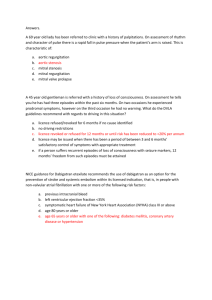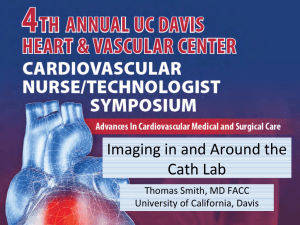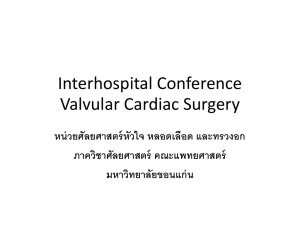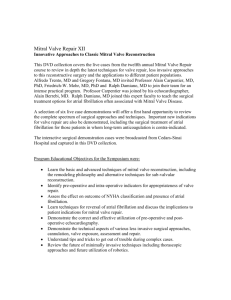Real-Time 3-Dimensional Transesophageal Echocardiography in
advertisement
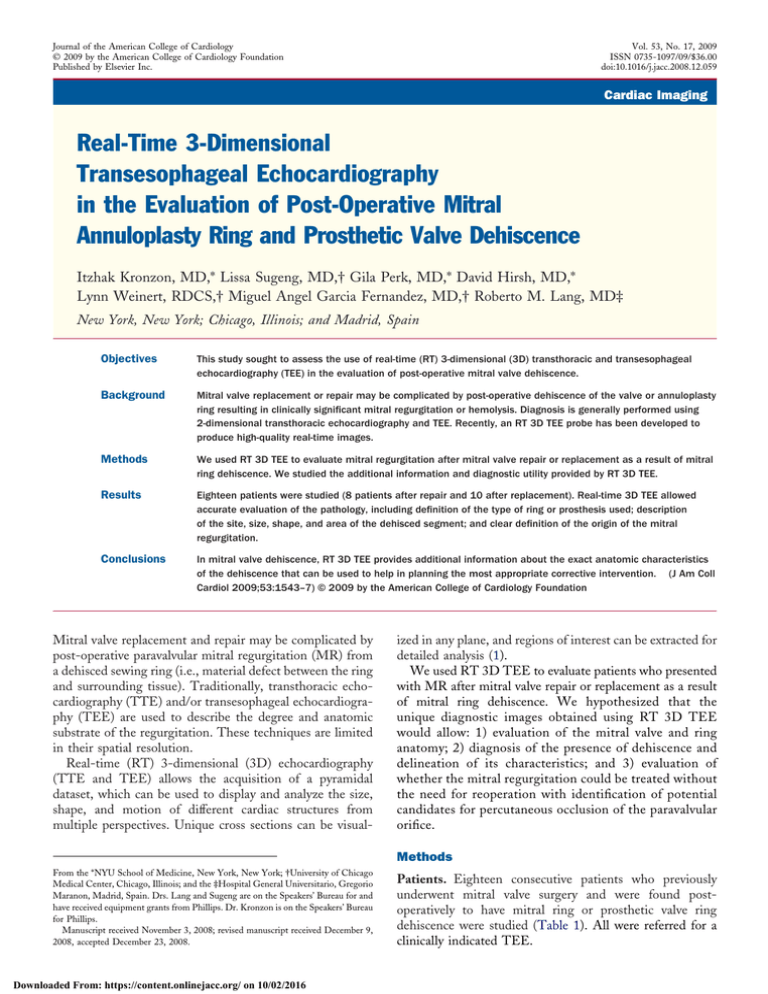
Journal of the American College of Cardiology © 2009 by the American College of Cardiology Foundation Published by Elsevier Inc. Vol. 53, No. 17, 2009 ISSN 0735-1097/09/$36.00 doi:10.1016/j.jacc.2008.12.059 Cardiac Imaging Real-Time 3-Dimensional Transesophageal Echocardiography in the Evaluation of Post-Operative Mitral Annuloplasty Ring and Prosthetic Valve Dehiscence Itzhak Kronzon, MD,* Lissa Sugeng, MD,† Gila Perk, MD,* David Hirsh, MD,* Lynn Weinert, RDCS,† Miguel Angel Garcia Fernandez, MD,† Roberto M. Lang, MD‡ New York, New York; Chicago, Illinois; and Madrid, Spain Objectives This study sought to assess the use of real-time (RT) 3-dimensional (3D) transthoracic and transesophageal echocardiography (TEE) in the evaluation of post-operative mitral valve dehiscence. Background Mitral valve replacement or repair may be complicated by post-operative dehiscence of the valve or annuloplasty ring resulting in clinically significant mitral regurgitation or hemolysis. Diagnosis is generally performed using 2-dimensional transthoracic echocardiography and TEE. Recently, an RT 3D TEE probe has been developed to produce high-quality real-time images. Methods We used RT 3D TEE to evaluate mitral regurgitation after mitral valve repair or replacement as a result of mitral ring dehiscence. We studied the additional information and diagnostic utility provided by RT 3D TEE. Results Eighteen patients were studied (8 patients after repair and 10 after replacement). Real-time 3D TEE allowed accurate evaluation of the pathology, including definition of the type of ring or prosthesis used; description of the site, size, shape, and area of the dehisced segment; and clear definition of the origin of the mitral regurgitation. Conclusions In mitral valve dehiscence, RT 3D TEE provides additional information about the exact anatomic characteristics of the dehiscence that can be used to help in planning the most appropriate corrective intervention. (J Am Coll Cardiol 2009;53:1543–7) © 2009 by the American College of Cardiology Foundation Mitral valve replacement and repair may be complicated by post-operative paravalvular mitral regurgitation (MR) from a dehisced sewing ring (i.e., material defect between the ring and surrounding tissue). Traditionally, transthoracic echocardiography (TTE) and/or transesophageal echocardiography (TEE) are used to describe the degree and anatomic substrate of the regurgitation. These techniques are limited in their spatial resolution. Real-time (RT) 3-dimensional (3D) echocardiography (TTE and TEE) allows the acquisition of a pyramidal dataset, which can be used to display and analyze the size, shape, and motion of different cardiac structures from multiple perspectives. Unique cross sections can be visual- ized in any plane, and regions of interest can be extracted for detailed analysis (1). We used RT 3D TEE to evaluate patients who presented with MR after mitral valve repair or replacement as a result of mitral ring dehiscence. We hypothesized that the unique diagnostic images obtained using RT 3D TEE would allow: 1) evaluation of the mitral valve and ring anatomy; 2) diagnosis of the presence of dehiscence and delineation of its characteristics; and 3) evaluation of whether the mitral regurgitation could be treated without the need for reoperation with identification of potential candidates for percutaneous occlusion of the paravalvular orifice. Methods From the *NYU School of Medicine, New York, New York; †University of Chicago Medical Center, Chicago, Illinois; and the ‡Hospital General Universitario, Gregorio Maranon, Madrid, Spain. Drs. Lang and Sugeng are on the Speakers’ Bureau for and have received equipment grants from Phillips. Dr. Kronzon is on the Speakers’ Bureau for Phillips. Manuscript received November 3, 2008; revised manuscript received December 9, 2008, accepted December 23, 2008. Downloaded From: https://content.onlinejacc.org/ on 10/02/2016 Patients. Eighteen consecutive patients who previously underwent mitral valve surgery and were found postoperatively to have mitral ring or prosthetic valve ring dehiscence were studied (Table 1). All were referred for a clinically indicated TEE. Kronzon et al. Real-Time 3D TEE in Mitral Valve Dehiscence 1544 Echocardiography. All patients underwent comprehensive 2dimensional (2D) TTE and 2D ⴝ 2-dimensional TEE. Mitral regurgitation was 3D ⴝ 3-dimensional assessed and graded according to MR ⴝ mitral regurgitation existing criteria. In addition, RT ⴝ real-time each patient had RT 3D TEE TEE ⴝ transesophageal that included: 1) narrow-angle echocardiography acquisition; 2) zoom mode; and TTE ⴝ transthoracic 3) full-volume wide-angle acquiechocardiography sition mode (1). All studies were performed with a commercially available echocardiography unit (iE33, Philips Medical Systems, Andover, Massachusetts). Mitral ring dehiscence was diagnosed as a segment of separation between the prosthetic ring and the patient’s native mitral annulus. Doppler color flow imaging was used to show the presence of mitral regurgitant flow through the dehisced segment. In patients with prosthetic ring dehiscence after mitral valve repair, the regurgitant jet appeared outside the ring but within the native valve annulus (para-ring), whereas in patients with a dehisced prosthetic mitral valve, the jet was paravalvular. The position, shape, and area of each dehiscence were measured and tabulated (Table 2). Abbreviations and Acronyms JACC Vol. 53, No. 17, 2009 April 28, 2009:1543–7 exact ring shape and type in patients with mitral valve repair, and the valvular anatomic appearance as seen from the atrial (surgeon’s view) and the ventricular perspectives in those with prosthetic valve (Figs. 2 and 3). The 2D TEE diagnosed dehisced mitral rings in most patients. A dehisced segment was defined as any material defect between ring and surrounding tissue. In 1 patient, dehiscence was suspected by the 2D images, but because of the lack of a mitral regurgitant jet through the gap between the native annulus and the ring, the diagnosis was ignored. The RT 3D TEE showed details of all of the dehisced segments; the exact site, size, shape, and area of the dehisced segment. These characteristics varied significantly; in 10 patients the dehiscence was posterior, in 4 it was lateral, in 1 patient medial, and in another, mainly anterior. In 2 patients, 2 sites of dehiscence were noted, and in 1 patient, 3 dehiscence sites were seen. The dehiscence shape varied from a slit (where the length is much larger than the width) to nearly a circular appearance. The severity of and the exact site of the mitral regurgitation (through the dehiscence/outside the ring, versus through the valve/through the ring, versus both) could be assessed in all patients. Discussion Results The clinical characteristics of the patients are summarized in Table 1. Using 2D TEE, the mitral prosthetic ring or mitral valve prosthesis was seen in each patient. The exact shape and type of the different mitral rings could not be assessed by the 2D TEE (Fig. 1). The RT 3D TEE showed the We have shown that in patients with mitral valve dehiscence, RT 3D TEE provides additional information about the exact anatomic characteristics of the dehisced segment as well as the relationship between the dehiscence and the mitral regurgitant jet(s). Dehiscence occurred mainly in a posterior or lateral location. There was only 1 anterior dehiscence. The reasons Clinical Characteristics of Patients Who Presented With a Dehisced Mitral Valve Table 1 Clinical Characteristics of Patients Who Presented With a Dehisced Mitral Valve Patient # Age (yrs) Sex Mitral Valve Surgery 1 77 M Repair Colvin-Galloway Heart failure 2 71 M Repair Carpentier-Edwards Endocarditis 3 63 F Repair Colvin-Galloway Heart failure 4 45 F Repair Colvin-Galloway Hemolysis 5 46 F Repair Carpentier-Edwards Heart failure 6 51 M Repair Geoform Heart failure 7 57 F Repair Carpentier-Edwards New murmur 8 42 F Repair Carpentier-Edwards Heart failure 9 63 M MVR St. Jude, mechanical Heart failure 10 45 F MVR St. Jude, mechanical Heart failure 11 79 M MVR St. Jude, mechanical Stroke 12 76 M MVR Bioprosthesis Transient ischemic attack 13 76 F MVR Bioprosthesis New-onset atrial fibrillation 14 54 M MVR Bioprosthesis Heart failure 15 49 M MVR Bioprosthesis Endocarditis 16 83 M MVR Bioprosthesis State after device closure of dehiscence/heart failure 17 39 F MVR Bioprosthesis Heart failure 18 65 M MVR Bioprosthesis Severe hemolysis MVR ⫽ mitral valve regurgitation. Downloaded From: https://content.onlinejacc.org/ on 10/02/2016 Type of Prosthesis/Ring Clinical Presentation Kronzon et al. Real-Time 3D TEE in Mitral Valve Dehiscence JACC Vol. 53, No. 17, 2009 April 28, 2009:1543–7 1545 Echocardiographic Characteristics of the Dehisced Mitral Valves Table 2 Echocardiographic Characteristics of the Dehisced Mitral Valves Mitral Regurgitation Dehiscence Characteristics Patient # Site Severity (0 to 3ⴙ) Position* Length (mm) Width (mm) Area (mm2) 1 PR, V 3 7 P 9 5 38 2 — 0 6 P 2 3 6 PR 3 6 P 7 6 36 4 PR 2 4 L 6 4 23 5 PR, V 3 5 P 18 8 103 6 PR 2 9 M 16 9 127 7 PR, V 2 5 L 8 3 19 8 PR 3 6 P 13 5 44 9 PV 3 7 P 11 6 48 10 PV 3 7 P 8 6 36 11 PV 1 3 L 10 2 16 12 PV, V 2 6 P 7 4 20 3 Location 13 PV 2 7 P 9 2 19 14 PV 3 5 P 16 3 38 15 PV 1 4 L 4 2 7 16 PV 3 3, 10 L, M 14 6 63 17 PV 3 4, 8 L, M 12 7 60 18 PV 3 11, 2, 6 A, P 10 5 35 *Location on a clock diagram. A ⫽ anterior location (11 to 1 on a clock diagram); L ⫽ lateral location (8 to 10 on a clock diagram); M ⫽ medial location (2 to 4 on a clock diagram); P ⫽ posterior location (5 to 7 on a clock diagram); PR ⫽ para-ring site; PV ⫽ paravalvular site; V ⫽ valvular site. for the prevalent occurrence of the dehiscence in the posterior part of the ring are: 1) the posterior annulus is in the far surgical field, thus limiting view while suturing; 2) the surgeon tries to avoid the circumflex artery, and therefore performs more superficial suturing posteriorly; and 3) calcifications and fibrosis of the mitral annulus are more prevalent posteriorly, making it less amenable to suturing. The information obtained by RT 3D TEE may provide important additional information that may be used in planning Figure 1 Dehisced Colvin-Galloway Ring, 2D Imaging (A) A 2-dimensional (2D) transesophageal echocardiography (TEE) image showing a dehiscence of the posterior aspect of the mitral annuloplasty ring. The exact ring type cannot be delineated, and the correct assessment of the dehiscence characteristics cannot be depicted. (B) A 2D TEE color Doppler image showing that the mitral regurgitation is para-ring (outside the annuloplasty ring but within the original mitral valve annulus). Downloaded From: https://content.onlinejacc.org/ on 10/02/2016 an appropriate intervention strategy. The number, location, shape, and site of the dehisced segment may be better identified on the beating heart. The presence of additional valve pathology may help in the type of surgery planned (dehiscence suturing alone or additional valve surgery). Percutaneous transcatheter occlusion of the dehiscence orifice in paravalvular mitral regurgitation is now feasible (2,3). The key to the success of this procedure is the accurate determination of the dehiscence characteristics. This information is now available using RT 3D TEE, and should improve patient selection and results of this procedure. Figure 4 shows the utility of RT 3D TEE imaging when performing such an occlusion. Surgical confirmation. Based on clinical presentation and echocardiographic findings, 10 patients underwent surgical repair. The site and dimension of the dehiscence were confirmed at the time of surgery in each patient. In addition, based on the RT 3D TEE results, 1 patient underwent a successful percutaneous closure of a dehisced mitral tissue prosthesis. Study limitations. The study was not randomized. The findings were not confirmed by pathology or surgery in one-third of the patients. It is, however, thought that clear demonstration of the dehiscence and the regurgitant flow across it are self-explanatory, and are superior to pathologic findings with an empty heart. Conclusions RT 3D TEE is an important addition to the diagnosis of mitral valve anatomy and pathophysiology. In the case of 1546 Figure 2 Kronzon et al. Real-Time 3D TEE in Mitral Valve Dehiscence JACC Vol. 53, No. 17, 2009 April 28, 2009:1543–7 Dehisced Carpentier-Edwards Ring, Real-Time 3-Dimensional Transesophageal Echocardiography (A) En face view from the left atrium showing a dehisced Carpentier-Edwards ring. The typical characteristics of this ring can clearly be seen: a closed ring with a straightened superior segment (*). (B) En face view from the left ventricular perspective. (C) Cropped image obtained from the full-volume image, clearly showing the mitral ring in place and the dehisced portion. (D) Full-volume color Doppler image showing 2 origins of the mitral regurgitation: para-ring mitral regurgitation through a dehisced segment and transvalvular mitral regurgitation from malcoaptation of the valve leaflets. Figure 3 Dehisced Mitral Prostheses (A) En face view from the left atrium. A bioprosthesis ring is seen, as well as the dehisced portion at the lateral aspect. (B) En face view from the left ventricle; the bioprosthesis struts are noted. (C) Diastolic frame of a St. Jude mechanical prosthesis, seen from the left atrial perspective. The paravalvular dehisced portion can be seen. (D) Using full-volume color Doppler acquisition, the mitral regurgitation can be clearly seen originating at the dehisced portion. Downloaded From: https://content.onlinejacc.org/ on 10/02/2016 Kronzon et al. Real-Time 3D TEE in Mitral Valve Dehiscence JACC Vol. 53, No. 17, 2009 April 28, 2009:1543–7 Figure 4 1547 Percutaneous Closure of Dehisced MTP (A) Dehisced mitral tissue prosthesis (MTP) as seen from the left atrial perspective. (B) Catheter placed through the dehisced portion of the prosthetic valve, seen from the left atrium. Corresponding 2-dimensional color Doppler image showing significant paravalvular mitral regurgitation. (C) Successful placement of an Amplatzer PDA occluder (seen from the left atrial perspective) and significant reduction in the mitral regurgitation (MR). mitral valve dehiscence, it provides additional information about the exact anatomic characteristics of the dehiscence. This in turn may help in planning the most appropriate method of corrective intervention. Reprint requests and correspondence: Dr. Gila Perk, NonInvasive Cardiology, NYU School of Medicine, 550 First Avenue, TH-2, HW-228, New York, New York 10016. E-mail: gila. perk@nyumc.org. Downloaded From: https://content.onlinejacc.org/ on 10/02/2016 REFERENCES 1. Sugeng L, Shernan SK, Salgo IS, et al. Live 3-dimensional transesophageal echocardiography: initial experience using the fully sampled matrix array probe. J Am Coll Cardiol 2008;52:446 –9. 2. Momplaisir T, Matthews RV. Paravalvular mitral regurgitation treated with an Amplatzer septal occluder device: a case report and review of the literature. J Invasive Cardiol 2007;19:E46 –50. 3. Sivakumar K, Shahani J. Transcatheter closure of paravalvular mitral prosthetic leak with resultant hemolysis. Int J Cardiol 2007;115:e39 – 40. Key Words: 3-dimensional echocardiography y transesophageal echocardiography y mitral valve.
